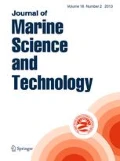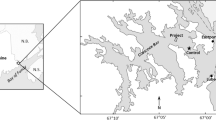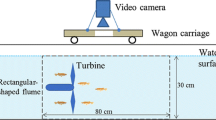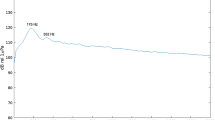Abstract
Understanding the risk of collision between tidal stream turbines and marine species is required for environmental impact assessment. Field observations are often limited by sensor capabilities. This study used a laboratory-scale water tank to monitor fine-scale fish behavior near a model of rotating turbine blades. Differences in behavior between three species were investigated: Oryzias latipes, Gnathopogon elongatus, and Rhodeus ocellatus ocellatus. Behavioral response under dark conditions was further investigated for Gnathopogon elongatus, as it showed active behavior near the turbine under bright conditions. 71% of fish actively avoided or swam away from the turbine during bright conditions. Under dark conditions, 92% avoided or swam away; fish approached less frequently and retreated sooner than in bright conditions. Alertness in dark conditions possibly increases due to the inability of fish to visually detect the blades; thus, dark conditions may not be directly linked to a higher collision risk. No striking events occurred which resulted in injury or mortality.

Figure adapted from Yoshida et al. [30]




Figure adapted from Yoshida et al. [30]

Figure adapted from Yoshida et al. [30]

Similar content being viewed by others
References
Copping A, Sather N, Hanna L, Whiting J, Zydlewski G, Staines G, Gill A, Hutchison I, O’Hagan A, Simas T, Bald J, Sparling C, Wood J, Masden E (2016). Annex IV 2016 State of the Science Report: Environmental Effects of Marine Renewable Energy Development Around the World, pp 224
Copping AE and Hemery LG (2020). OES-Environmental 2020 State of the Science Report: Environmental Effects of Marine Renewable Energy Development Around the World. Report for Ocean Energy Systems (OES). https://doi.org/10.2172/1632878
Bevelhimer M, Scherelis C, Colby J, Adonizio MA (2017) Hydroacoustic assessment of behavioral responses by fish passing near an operating tidal turbine in the east river, New York. Trans Am Fish Soc 146:1028–1042. https://doi.org/10.1080/00028487.2017.1339637
Schramm MP, Bevelhimer M, Scherelis C (2017) Effects of hydrokinetic turbine sound on the behavior of four species of fish within an experimental mesocosm. Fish Res 190:1–14. https://doi.org/10.1016/j.fishres.2017.01.012
Viehman HA, Zydlewski GB, McCleave JD, Staines GJ (2014) Using hydroacoustics to understand fish presence and vertical distribution in a tidally dynamic region targeted for energy extraction. Estuaries Coasts 38:215–226. https://doi.org/10.1007/s12237-014-9776-7
Viehman HA, Zydlewski GB (2015) Fish interactions with a commercial-scale tidal energy device in the natural environment. Estuaries Coasts 38:241–252. https://doi.org/10.1007/s12237-014-9767-8
Viehman HA, Zydlewski GB (2017) Multi-scale temporal patterns in fish presence in a high velocity tidal channel. PLoS ONE 12:1–20. https://doi.org/10.1371/journal.pone.0176405
Shen H, Zydlewski GB, Viehman HA, Staines G (2016) Estimating the probability of fish encountering a marine hydrokinetic device. Renew Energy 97:746–756. https://doi.org/10.1016/j.renene.2016.06.026
Staines G, Zydlewski G, Viehman H (2019) Changes in relative fish density around a deployed tidal turbine during on-water activities. Sustainability 11:1–12. https://doi.org/10.3390/su11226262
Taormina B, Laurans M, Marzloff MP et al (2020) Renewable energy homes for marine life: habitat potential of a tidal energy project for benthic megafauna. Mar Environ Res. https://doi.org/10.1016/j.marenvres.2020.105131
Williamson BJ, Fraser S, Blondel P et al (2017) Multisensor acoustic tracking of fish and seabird behavior around tidal turbine structures in Scotland. IEEE J Ocean Eng 42:948–965. https://doi.org/10.1109/JOE.2016.2637179
Williamson B, Fraser S, Williamson L et al (2019) Predictable changes in fish school characteristics due to a tidal turbine support structure. Renew Energy 141:1092–1102. https://doi.org/10.1016/j.renene.2019.04.065
Williamson BJ, Blondel P, Williamson LD, Scott BE (2021) Application of a multibeam echosounder to document changes in animal movement and behaviour around a tidal turbine structure. ICES J Mar Sci 78:1253–1266. https://doi.org/10.1093/icesjms/fsab017
Krone R, Dederer G, Kanstinger P et al (2017) Mobile demersal megafauna at common offshore wind turbine foundations in the German Bight (North Sea) two years after deployment—increased production rate of Cancer pagurus. Mar Environ Res 123:53–61. https://doi.org/10.1016/j.marenvres.2016.11.011
Langhamer O, Holand H, Rosenqvist G (2016) Effects of an Offshore Wind Farm (OWF) on the common shore crab Carcinus maenas: tagging pilot experiments in the Lillgrund Offshore Wind Farm (Sweden). PLoS ONE 11:1–17. https://doi.org/10.1371/journal.pone.0165096
van Hal R, Griffioen AB, van Keeken OA (2017) Changes in fish communities on a small spatial scale, an effect of increased habitat complexity by an offshore wind farm. Mar Environ Res 126:26–36. https://doi.org/10.1016/j.marenvres.2017.01.009
Wilber DH, Carey DA, Griffin M (2018) Flatfish habitat use near North America’s first offshore wind farm. J Sea Res 139:24–32. https://doi.org/10.1016/j.seares.2018.06.004
Wright SR, Lynam CP, Righton DA et al (2020) Structure in a sea of sand: fish abundance in relation to man-made structures in the North Sea. ICES J Mar Sci 77:1206–1218. https://doi.org/10.1093/icesjms/fsy142
Langhamer O, Wilhelmsson D (2009) Colonisation of fish and crabs of wave energy foundations and the effects of manufactured holes—a field experiment. Mar Environ Res 68:151–157. https://doi.org/10.1016/j.marenvres.2009.06.003
Bender A, Langhamer O, Sundberg J (2020) Colonisation of wave power foundations by mobile mega- and macrofauna—a 12 year study. Mar Environ Res 161:105053. https://doi.org/10.1016/j.marenvres.2020.105053
Todd VLG, Williamson LD, Cox SE et al (2020) Characterizing the first wave of fish and invertebrate colonization on a new offshore petroleum platform. ICES J Mar Sci 77:1127–1136. https://doi.org/10.1093/icesjms/fsz077
Todd VLG, Susini I, Williamson LD et al (2021) Characterizing the second wave of fish and invertebrate colonization of an offshore petroleum platform. ICES J Mar Sci 78:1253–1266. https://doi.org/10.1093/icesjms/fsaa245
Meyer-Gutbrod EL, Kui L, Nishimoto MM et al (2019) Fish densities associated with structural elements of oil and gas platforms in southern California. Bull Mar Sci 95:639–656. https://doi.org/10.5343/bms.2018.0078
Schutter M, Dorenbosch M, Driessen FMF et al (2019) Oil and gas platforms as artificial substrates for epibenthic North Sea fauna: effects of location and depth. J Sea Res 153:101782. https://doi.org/10.1016/j.seares.2019.101782
Amaral S, Perkins N, Giza D, McMahon B (2011) Evaluation of fish injury and mortality associated with hydrokinetic turbines (Report No. 1024569), Report by Alden Research Laboratory. Report for Electric Power Research Institute (EPRI)
Amaral S, Giza D, McMahon B (2014) Evaluation of survival and behavior of fish exposed to an axial-flow hydrokinetic turbine (Report No. 3002003911), Report by Alden Research Laboratory. Report for Electric Power Research Institute (EPRI)
Castro-Santos T, Haro A (2013) Survival and behavioral effects of exposure to a hydrokinetic turbine on juvenile Atlantic Salmon and adult American Shad. Estuaries Coasts 38:203–214. https://doi.org/10.1007/s12237-013-9680-6
Taya S (2015) Behavioral assessment of marine animals subjected to hydrokinetic turbines. Master thesis, Univ Tokyo
Zhang J, Kitazawa D, Taya S, Mizukami Y (2017) Impact assessment of marine current turbines on fish behavior using an experimental approach based on the similarity law. J Mar Sci Technol 22:219–230. https://doi.org/10.1007/s00773-016-0405-y
Yoshida T, Zhou J, Park S et al (2020) Use of a model turbine to investigate the high striking risk of fish with tidal and oceanic current turbine blades under slow rotational speed. Sustain Energy Technol Assess 37:100634. https://doi.org/10.1016/j.seta.2020.100634
Triantafyllou GS, Triantafyllou MS, Grosenbaugh MA (1993) Optimal thrust development in oscillating foils with application to fish propulsion. J Fluids Struct 7:205–224
Bainbridge BYR (1958) The speed of swimming of fish as related to size and to the frequency and amplitude of the tail beat. J Exp Biol 35:109–133
Acknowledgements
This study was supported by a collaborative research program of The Japan Society of Naval Architects and Ocean Engineers (JASNAOE). We gratefully acknowledge the constructive comments from reviewers.
Author information
Authors and Affiliations
Corresponding author
Ethics declarations
Conflict of interest
The authors have no conflicts of interest to declare.
Additional information
Publisher's Note
Springer Nature remains neutral with regard to jurisdictional claims in published maps and institutional affiliations.
About this article
Cite this article
Yoshida, T., Furuichi, D., Williamson, B. et al. Experimental study of fish behavior near a tidal turbine model under dark conditions. J Mar Sci Technol 27, 541–548 (2022). https://doi.org/10.1007/s00773-021-00850-w
Received:
Accepted:
Published:
Issue Date:
DOI: https://doi.org/10.1007/s00773-021-00850-w




